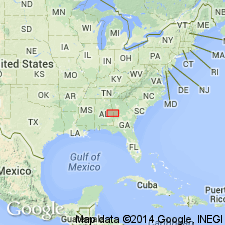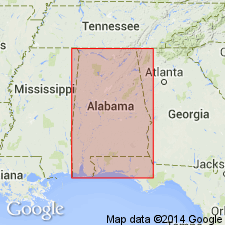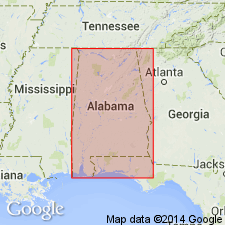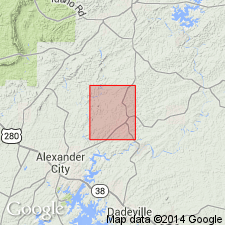
- Usage in publication:
-
- Zana Granite
- Modifications:
-
- Named
- Dominant lithology:
-
- Granite
- AAPG geologic province:
-
- Piedmont-Blue Ridge province
Summary:
Zana Granite, named for its typical development and good exposure near community of Zana, Tallapoosa Co., east-central AL, intrudes rocks of the Heard Group. Consists of a number of quartz-monzonite plutons with halos of large potassium-feldspar porphyroblasts. Mineral assemblage consists of microcline, oligoclase, quartz, muscovite, and biotite. Accessory minerals include apatite, zircon, and opaques. Halos, in places developed in adjacent schists, may be several hundred ft thick. Occurrence of these porphyroblastic zones has been mapped along strike in the middle part of the Tallapoosa block for more than 12 mi. Plutons interlayered with the schist of the Heard Group to the north, and also to the south do not have these zones.
Source: GNU records (USGS DDS-6; Reston GNULEX).

- Usage in publication:
-
- Zana Granite
- Modifications:
-
- Areal extent
- Overview
- AAPG geologic province:
-
- Piedmont-Blue Ridge province
Summary:
Zana granite has been mapped for up to 65 km along strike. Recent studies show that earlier work needs re-evaluation. The Zana comprises several different petrographic types and may include granites of several ages. Zana may be apophyses off larger Kowaliga intrusion, as the two are actually connected near Fosheeton. Conventional use of the term Zana should be abandoned.
Source: GNU records (USGS DDS-6; Reston GNULEX).

- Usage in publication:
-
- Zana Granite
- Modifications:
-
- Geochronologic dating
- Overview
- AAPG geologic province:
-
- Piedmont-Blue Ridge province
Summary:
Term Zana Granite applied to a narrow strip of granitic rock parallel to Kowaliga Gneiss to the northwest. Well-exposed outcrop of strongly banded, fine-grained muscovite-biotite granitic gneiss near Daviston, Tallapoosa Co. Contains significantly more muscovite and potassium feldspar than Kowaliga Gneiss. U-Pb zircon and Rb-Sr whole-rock analyses indicate Kowaliga and Zana Granite both formed 460 m.y. ago but were either from separate magmas or Zana is contaminated by country rock.
Source: GNU records (USGS DDS-6; Reston GNULEX).

- Usage in publication:
-
- Zana Granite
- Modifications:
-
- Overview
- AAPG geologic province:
-
- Piedmont-Blue Ridge province
Summary:
Zana Granite as used by the Geological Survey of Alabama is a quartz monzonite to granite with gneissic texture occurring in the northern Piedmont of east-central AL. Unit is generally elongate, semiconcordant to foliation of country rock, and cut by small pegmatites and aplite dikes. Age is Ordovician.
Source: GNU records (USGS DDS-6; Reston GNULEX).

- Usage in publication:
-
- Zana Granite
- Modifications:
-
- Overview
- AAPG geologic province:
-
- Piedmont-Blue Ridge province
Summary:
Occurs as thin tabular bodies within the Emuckfaw Group. Zana comprises several different petrographic types from muscovite granite gneiss to biotite-bearing granodiorite with no one diagnostic rock type. An intensely sheared granite gneiss that separates the informal Josie Leg and Timbergut formations of the Emuckfaw Group in the study area is here assigned to the Zana Granite. Unit thought to have premetamorphic intrusive contacts with the Emuckfaw and therefore provides an upper age limit of Middle Ordovician for the Emuckfaw.
Source: GNU records (USGS DDS-6; Reston GNULEX).
For more information, please contact Nancy Stamm, Geologic Names Committee Secretary.
Asterisk (*) indicates published by U.S. Geological Survey authors.
"No current usage" (†) implies that a name has been abandoned or has fallen into disuse. Former usage and, if known, replacement name given in parentheses ( ).
Slash (/) indicates name conflicts with nomenclatural guidelines (CSN, 1933; ACSN, 1961, 1970; NACSN, 1983, 2005, 2021). May be explained within brackets ([ ]).

